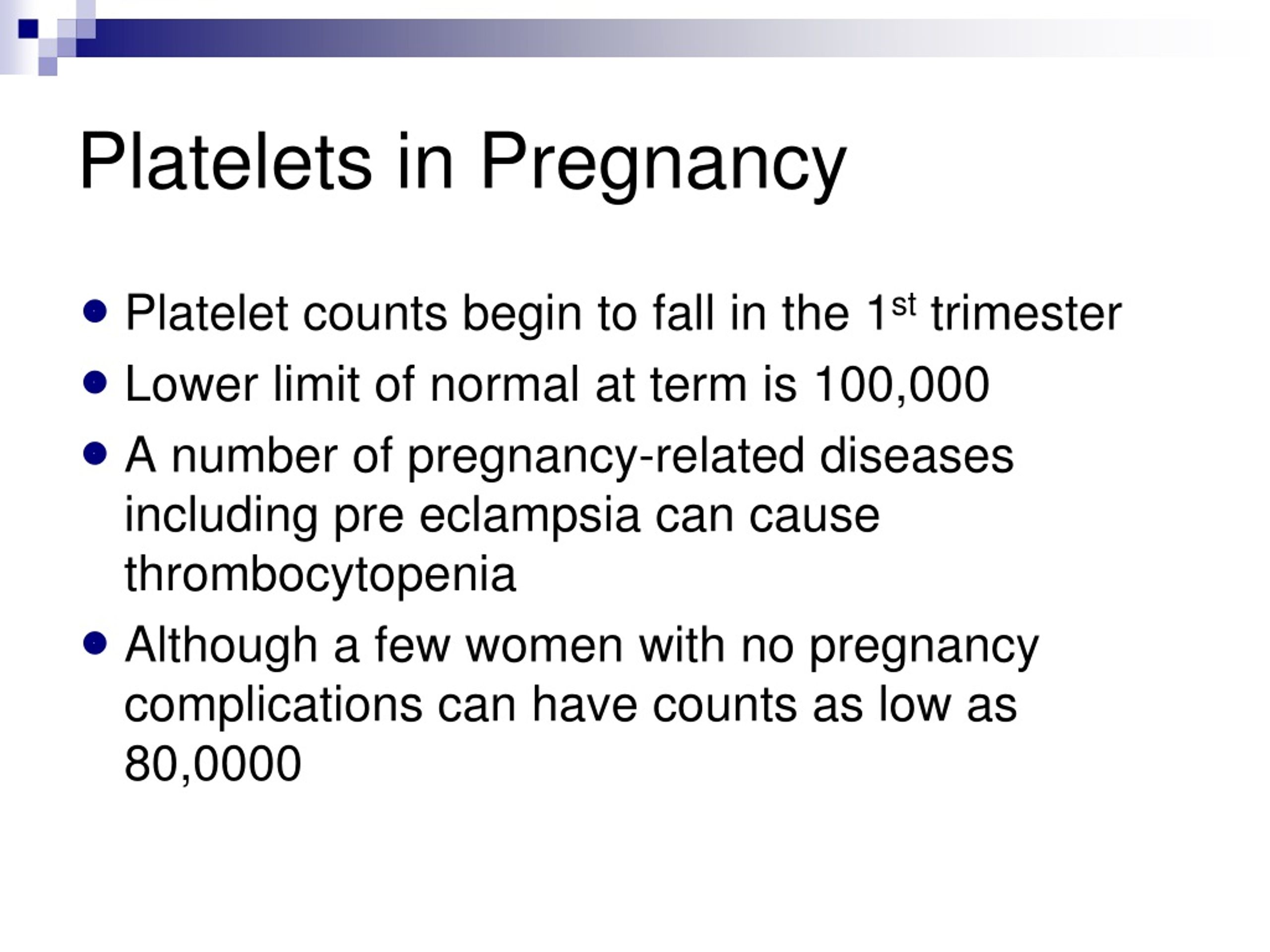Normal Platelet Count During Pregnancy
Normal Platelet Count During Pregnancy - Platelet counts of less than 150,000 per cubic millimeter during uncomplicated pregnancies are described as gestational thrombocytopenia if. Normal platelet count in pregnancy. Platelet count < 150 x. Causes of a high and low platelet count. Normal pregnancy is characterized by an increase in platelet aggregation and a decrease in the number of circulating platelets with gestation. Most guidelines raise concern at platelet count < 100 x 10^9 /l, which occurs in < 1% of all term deliveries.
Causes of a high and low platelet count. Platelet count < 150 x. Most guidelines raise concern at platelet count < 100 x 10^9 /l, which occurs in < 1% of all term deliveries. Platelet counts of less than 150,000 per cubic millimeter during uncomplicated pregnancies are described as gestational thrombocytopenia if. Normal pregnancy is characterized by an increase in platelet aggregation and a decrease in the number of circulating platelets with gestation. Normal platelet count in pregnancy.
Normal pregnancy is characterized by an increase in platelet aggregation and a decrease in the number of circulating platelets with gestation. Normal platelet count in pregnancy. Most guidelines raise concern at platelet count < 100 x 10^9 /l, which occurs in < 1% of all term deliveries. Causes of a high and low platelet count. Platelet counts of less than 150,000 per cubic millimeter during uncomplicated pregnancies are described as gestational thrombocytopenia if. Platelet count < 150 x.
Platelet Counts during Pregnancy NEJM
Normal platelet count in pregnancy. Most guidelines raise concern at platelet count < 100 x 10^9 /l, which occurs in < 1% of all term deliveries. Platelet count < 150 x. Normal pregnancy is characterized by an increase in platelet aggregation and a decrease in the number of circulating platelets with gestation. Platelet counts of less than 150,000 per cubic.
(PDF) Evaluation of platelet count and platelet distribution width
Most guidelines raise concern at platelet count < 100 x 10^9 /l, which occurs in < 1% of all term deliveries. Platelet counts of less than 150,000 per cubic millimeter during uncomplicated pregnancies are described as gestational thrombocytopenia if. Normal platelet count in pregnancy. Causes of a high and low platelet count. Platelet count < 150 x.
Flow chart of platelet counts during pregnancy of a woman giving birth
Platelet count < 150 x. Causes of a high and low platelet count. Normal platelet count in pregnancy. Most guidelines raise concern at platelet count < 100 x 10^9 /l, which occurs in < 1% of all term deliveries. Platelet counts of less than 150,000 per cubic millimeter during uncomplicated pregnancies are described as gestational thrombocytopenia if.
Understanding High Platelet Count During Pregnancy Is It Normal
Normal platelet count in pregnancy. Most guidelines raise concern at platelet count < 100 x 10^9 /l, which occurs in < 1% of all term deliveries. Causes of a high and low platelet count. Platelet counts of less than 150,000 per cubic millimeter during uncomplicated pregnancies are described as gestational thrombocytopenia if. Platelet count < 150 x.
Thrombocytopaenia in Pregnancy Dr Guan Yong Khee Hospital
Normal pregnancy is characterized by an increase in platelet aggregation and a decrease in the number of circulating platelets with gestation. Causes of a high and low platelet count. Platelet count < 150 x. Most guidelines raise concern at platelet count < 100 x 10^9 /l, which occurs in < 1% of all term deliveries. Platelet counts of less than.
Understanding The Normal Platelet Count Range During Pregnancy ShunChild
Platelet counts of less than 150,000 per cubic millimeter during uncomplicated pregnancies are described as gestational thrombocytopenia if. Most guidelines raise concern at platelet count < 100 x 10^9 /l, which occurs in < 1% of all term deliveries. Normal pregnancy is characterized by an increase in platelet aggregation and a decrease in the number of circulating platelets with gestation..
Platelet Counts during Pregnancy NEJM
Most guidelines raise concern at platelet count < 100 x 10^9 /l, which occurs in < 1% of all term deliveries. Platelet count < 150 x. Normal platelet count in pregnancy. Platelet counts of less than 150,000 per cubic millimeter during uncomplicated pregnancies are described as gestational thrombocytopenia if. Causes of a high and low platelet count.
What Is a Normal Platelet Count In Pregnancy? — JournalFeed
Normal platelet count in pregnancy. Platelet count < 150 x. Normal pregnancy is characterized by an increase in platelet aggregation and a decrease in the number of circulating platelets with gestation. Causes of a high and low platelet count. Most guidelines raise concern at platelet count < 100 x 10^9 /l, which occurs in < 1% of all term deliveries.
PPT PHYSIOLOGY OF PREGNANCY PowerPoint Presentation, free download
Normal pregnancy is characterized by an increase in platelet aggregation and a decrease in the number of circulating platelets with gestation. Most guidelines raise concern at platelet count < 100 x 10^9 /l, which occurs in < 1% of all term deliveries. Platelet count < 150 x. Platelet counts of less than 150,000 per cubic millimeter during uncomplicated pregnancies are.
Platelet Counts during Pregnancy NEJM
Causes of a high and low platelet count. Normal platelet count in pregnancy. Platelet count < 150 x. Platelet counts of less than 150,000 per cubic millimeter during uncomplicated pregnancies are described as gestational thrombocytopenia if. Most guidelines raise concern at platelet count < 100 x 10^9 /l, which occurs in < 1% of all term deliveries.
Normal Pregnancy Is Characterized By An Increase In Platelet Aggregation And A Decrease In The Number Of Circulating Platelets With Gestation.
Causes of a high and low platelet count. Platelet counts of less than 150,000 per cubic millimeter during uncomplicated pregnancies are described as gestational thrombocytopenia if. Normal platelet count in pregnancy. Most guidelines raise concern at platelet count < 100 x 10^9 /l, which occurs in < 1% of all term deliveries.









